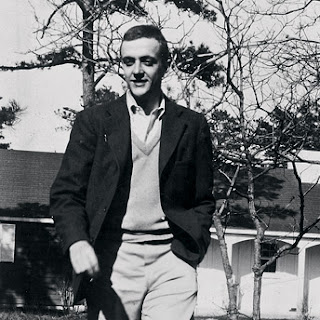Vonnegut's third novel, Mother Night, first published in 1961, is an orphaned work of sorts. As Doris Lessing notes in her 1973 New York Times review of the book, noting that it's "the Vonnegut book that has not been reviewed anywhere, ever, because it was sold first into paperback for a handy sum: he needed the money for his large family. And paperbacks don't get reviewed, so it has been ordained." Beyond that, as The Nation points out, "The book is anomalous in Vonnegut's oeuvre, his only novel not to feature elements of the fantastic, and in that sense and others — its sober tone, its attempt to depict mature love — his most adult."
Charles Shields gives us the basic setup for the novel:
The protagonist is Howard W. Campbell Jr., an American imprisoned in Tel Aviv, accused of having aided the Nazis. Vonnegut imagined him as someone like William Joyce, the Irishman nicknamed "Lord Haw Haw" who broadcast during the war from Berlin. Kurt had listened to him while stationed in England, wondering what could motivate a turncoat. The other inspiration was the phony Red Cross worker in Dresden who tried to recruit POWs for combat on the Russian front by promising better food and clothing. Perhaps, Vonnegut imagined, he wasn't a German actor with an impeccable English accent, but an American engaged in a complicated double cross.
The book is framed as Campbell's autobiography, for which Vonnegut has served as editor. A latter edition, which contains a separate introductory note penned in 1966, offers some new insights to frame the book's contents: "This is the only story of mine whose moral I know. I don't think it's a marvelous moral; I simply happen to know what it is: We are what we pretend to be, so we must be careful about what we pretend to be." Recall these lines when we get to Slaughterhouse-Five, where they'll be echoed in his discussion of the long and arduous process of coming to terms with his experiences in WWII (n.b. Campbell makes an appearance as well). Still, it would take Vonnegut another eight years to reach that point. In Mother Night, we see his first book-length effort to work through his personal history and the nation's as well.
Here's our reading schedule for Mother Night:
- Mon. September 5: No Class — Labor Day
- Weds. September 7: introduction, editor's note, chapters 1–13
- Fri. September 9: chapters 14–25
- Mon. September 12: chapters 26–36
- Weds. September 14: chapters 37–45
And here are a few supplemental resources:
- "The Guest Word" — Doris Lessing's NYT review of Mother Night: [link]
- a brief essay on the novel at Alphabet Rain: [link]
- Wikipedia entry on Lord Haw-Haw: [link]
- the trailer for a 1996 film adaptation of the book: [link]




